Text and pictures by Dr. Erik Bjurstrom
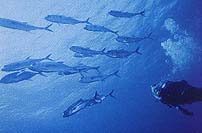 How had I ended up in this situation? As a fifteen year old boy I had read Cousteau's account of diving on the Farasan Bank in the Saudi Arabian Red Sea and had become fascinated with the area. The 'Bank', is an extensive shoal of coral reefs that runs about 320 miles from west of the coastal town of Al Lith down to Kamaran Island. It is a shallow area where extensive reefs have created beautiful coral gardens. Cousteau, in his book The Living Sea, describes this area as one of the most interesting coral ecosystems in the world. It is isolated, surrounded by sea and desert and relatively unaffected by tourists, fishing or pollution.When I eventually came to work in Saudi Arabia, at Khamis Mushayt, in 1981, I enthusiastically packed my cases with diving equipment. I was determined to explore the underwater world of the Farasan Bank. To my surprise, when I enquired locally about the reefs of the Farasan Bank I was met with many negative comments. Few seemed to know anything about the area. A number of divers whom I met told me there was nothing out there and they only dove the shore reefs. Local fishermen told me the area comprised only desolated islands with no fresh-water. Around them were seas full of dangerous sharks that would regard me as a welcome change in their diet. I was assured that they would swallow me immediately and that nobody ventured out over the Bank voluntarily.
How had I ended up in this situation? As a fifteen year old boy I had read Cousteau's account of diving on the Farasan Bank in the Saudi Arabian Red Sea and had become fascinated with the area. The 'Bank', is an extensive shoal of coral reefs that runs about 320 miles from west of the coastal town of Al Lith down to Kamaran Island. It is a shallow area where extensive reefs have created beautiful coral gardens. Cousteau, in his book The Living Sea, describes this area as one of the most interesting coral ecosystems in the world. It is isolated, surrounded by sea and desert and relatively unaffected by tourists, fishing or pollution.When I eventually came to work in Saudi Arabia, at Khamis Mushayt, in 1981, I enthusiastically packed my cases with diving equipment. I was determined to explore the underwater world of the Farasan Bank. To my surprise, when I enquired locally about the reefs of the Farasan Bank I was met with many negative comments. Few seemed to know anything about the area. A number of divers whom I met told me there was nothing out there and they only dove the shore reefs. Local fishermen told me the area comprised only desolated islands with no fresh-water. Around them were seas full of dangerous sharks that would regard me as a welcome change in their diet. I was assured that they would swallow me immediately and that nobody ventured out over the Bank voluntarily.
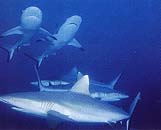 With such a dearth of first-hand experience on which to base my plans it became clear that the only way to familiarise myself with the offshore area of the Bank was by exploring it for myself. With the aid of an English admiralty chart, drawn in 1918, I selected an island that looked interesting, loaded two inflatables with friends and diving equipment, plotted a compass course, and set out towards the unknown. The sea was calm and the sun burned our shoulders. This was July. The thermometer stood at 50°C and the horizon shimmered in the rising heat. We had a spare engine and lots of extra water and fuel with us and as we sped across the calm sea with a cooling breeze in my face I was ecstatically contended. This was what I had often dreamed of doing. Before long we were rewarded with a taste of the richness of these waters as a school of pilot whales changed course, heading straight for us and playing with our boats. They swam up from behind, dove under a boat and then jumped in front of it. All the time we could hear them communicating in high whistling sounds.
With such a dearth of first-hand experience on which to base my plans it became clear that the only way to familiarise myself with the offshore area of the Bank was by exploring it for myself. With the aid of an English admiralty chart, drawn in 1918, I selected an island that looked interesting, loaded two inflatables with friends and diving equipment, plotted a compass course, and set out towards the unknown. The sea was calm and the sun burned our shoulders. This was July. The thermometer stood at 50°C and the horizon shimmered in the rising heat. We had a spare engine and lots of extra water and fuel with us and as we sped across the calm sea with a cooling breeze in my face I was ecstatically contended. This was what I had often dreamed of doing. Before long we were rewarded with a taste of the richness of these waters as a school of pilot whales changed course, heading straight for us and playing with our boats. They swam up from behind, dove under a boat and then jumped in front of it. All the time we could hear them communicating in high whistling sounds.
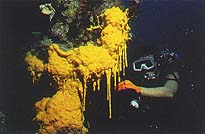 An hour later we noticed what seemed to be a line of bushes on the horizon. Through the heat haze it looked like a mirage but soon materialised into an island surrounded by a reef. The shallow water inside was an iridescent green and as soon as we reached the reef-edge I could not resist the temptation to put on mask and flippers for a quick look before going ashore. A fairy-tale landscape of corals of all shapes extended before me. Magnificent brightly coloured soft coral trees were surrounded by schools of fish that swam among them in long flowing processions, like streams of molten silver. Bright sunlight reflected from the fish, forming a glittering curtain of light. Attracted by the activity, schools of hunting jacks and barracudas approached, agilely turning directly in front of me. As I descended a tunnel opened among the shoaling fish and I found myself on the sea-bed. A large parrotfish that I had disturbed swam away leaving a trail of pulverised coral. A blue spotted stingray that had been lying on the sand followed suit, disappearing in a cloud of sand. The smaller coral fish carried on grazing the algae, unperturbed by my presence.
An hour later we noticed what seemed to be a line of bushes on the horizon. Through the heat haze it looked like a mirage but soon materialised into an island surrounded by a reef. The shallow water inside was an iridescent green and as soon as we reached the reef-edge I could not resist the temptation to put on mask and flippers for a quick look before going ashore. A fairy-tale landscape of corals of all shapes extended before me. Magnificent brightly coloured soft coral trees were surrounded by schools of fish that swam among them in long flowing processions, like streams of molten silver. Bright sunlight reflected from the fish, forming a glittering curtain of light. Attracted by the activity, schools of hunting jacks and barracudas approached, agilely turning directly in front of me. As I descended a tunnel opened among the shoaling fish and I found myself on the sea-bed. A large parrotfish that I had disturbed swam away leaving a trail of pulverised coral. A blue spotted stingray that had been lying on the sand followed suit, disappearing in a cloud of sand. The smaller coral fish carried on grazing the algae, unperturbed by my presence.
As our boat gradually approached the shore we heard a big splash behind us and a tall fin split the water, followed by a second, parallel to the first. It was a manta ray, one of the largest of the Red Sea's fish that can grow up to five metres from wing tip to wing tip and weigh several tons. We prepared our camera equipment quickly and jumped into the water in order to photograph these harmless plankton eaters. A large manta was heading my way; it was an overwhelming sight, with slow graceful wing movements it seemed like a giant bird, flying through the water. I was reminded of pictures of the prehistoric pterodactyl. Its mouth was wide open, funnelling plankton-laden water through the gills. In front of the its cavernous gape was a school of pilot fish and on its white belly were two sucker fish. It stopped just in front of me. One eye seemed to gaze at me curiously for a moment and then, with an elegant flip of its wings, the manta turned away.
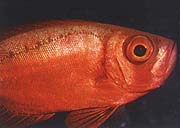 The next day we headed for Denham Reef, a mile from Hadara. Underwater the coral landscape was dominated by huge boulders of Porites with massive table corals formed by branched Acropora and abundant Millepora fire corals. A movement on thesea bed drew my attention to two octopuses in an intimate embrace. The camera's flash caused them to suddenly change colour, becoming as white as snow. As they moved away, their bodies continuously changed colours like neon lights.
The next day we headed for Denham Reef, a mile from Hadara. Underwater the coral landscape was dominated by huge boulders of Porites with massive table corals formed by branched Acropora and abundant Millepora fire corals. A movement on thesea bed drew my attention to two octopuses in an intimate embrace. The camera's flash caused them to suddenly change colour, becoming as white as snow. As they moved away, their bodies continuously changed colours like neon lights.
We were eager to meet the reef's sharks and did not have to wait long for our first encounter. Diving along the outer reef of Hadara I saw a streak of silver grey to one side of my clear vision. Five reef sharks, about a metre and a half in length, circled around us. They did not seem aggressive, only curious. I could not help admiring their beautifully shaped bodies as they slowly glided through the water in total harmony with their environment. After satisfying their curiosity, they disappeared quickly. We met them many times after that and lost our fear for them but never our respect. At one time, outside Jabal Sabaya, they had as usual come like a pack of watchdogs and then left. I was lying on the bottom in shallow water using up the last frames of film. I looked up and saw my diving colleague making gestures, pointing at something behind my back. I turned around and confronted a shark coming at me with a determined look in his eye. I triggered the flash which deflected the the shark which merely scraped my leg with his tail. As a souvenir I have a blurred close-up of a shark's jaws. Later we met several sharks that showed the same nervous territorial aggressiveness so typical of the grey reef shark, the most common species on central Red Sea reefs.
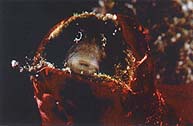 We soon learned that the only way we could attract the sharks long enough to get good pictures was to tempt them with fish bait. Our first experiment had succeeded only too well as told in the beginning of this article and now the situation was out of control. We threw away the bags of fish as if they were live hand grenades. With our backs to each other and holding knives in front of us, we withdrew towards the reef wall and up to the surface. Fortunately the sharks were attracted to the bags of bait not ourselves. In later photography sessions we tied the bait to the coral and achieved better control. Our close encounters showed us however that we had underestimated their power. On one occasion we watched as two sharks, with violent head sawing movements cut a three pound fish in half in seconds.
We soon learned that the only way we could attract the sharks long enough to get good pictures was to tempt them with fish bait. Our first experiment had succeeded only too well as told in the beginning of this article and now the situation was out of control. We threw away the bags of fish as if they were live hand grenades. With our backs to each other and holding knives in front of us, we withdrew towards the reef wall and up to the surface. Fortunately the sharks were attracted to the bags of bait not ourselves. In later photography sessions we tied the bait to the coral and achieved better control. Our close encounters showed us however that we had underestimated their power. On one occasion we watched as two sharks, with violent head sawing movements cut a three pound fish in half in seconds.
The months passed by and we spent all our free time diving. We became familiar with these little-known reefs and learned to recognise the behaviour and habits of the fish. Our pictures also improved. We felt like astronauts visiting another planet. The names Hadara, Jabal Sabaya and Abu Latt became for us synonymous with adventure. For me personally, Farasan means something that very few people are fortunate enough to experience: to realise one's boyhood dream.
Arabian Wildlife. Volume 1, Number 2